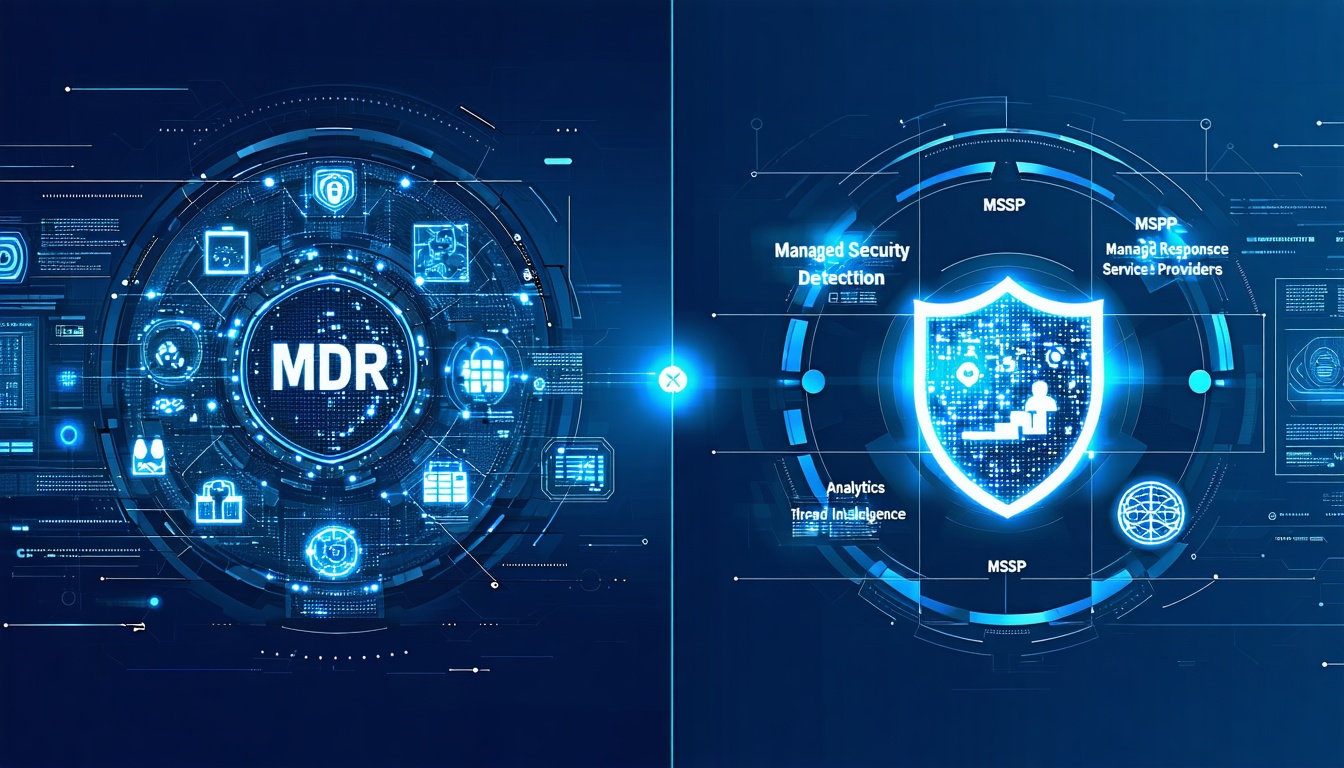Understanding MDR and MSSP
In an evolving cyber threat landscape, organizations often compare mdr vs mssp when outsourcing security operations. Managed Detection and Response, or MDR, emphasizes threat identification, investigation, and active containment. In contrast, a Managed Security Service Provider generally focuses on infrastructure management and alerting. Both models aim to strengthen an enterprise’s security posture, but differences in scope, response speed, and human involvement shape which solution aligns best with strategic objectives.
MDR Overview
Managed Detection and Response providers combine advanced analytics, machine learning, and human expertise to hunt for sophisticated threats across endpoints, networks, identity systems, and cloud environments. Services cover continuous monitoring, high-fidelity threat detection, automated containment, and in-depth forensic analysis. Organizations may consider managed detection and response companies when internal teams lack 24/7 threat hunting capabilities or specialized incident response expertise.
MSSP Overview
A Managed Security Service Provider delivers broad monitoring and management of security infrastructure—firewalls, intrusion detection systems, endpoint protection, patch management, and periodic audits. MSSPs generate validated alerts for an organization’s security team to investigate. They excel in delivering reliable, cost-effective security operations for businesses building their IT function, though they stop short of active threat resolution in most cases.
Service Model Comparison
- MDR combines proactive threat hunting and guided or full incident response, reducing attacker dwell time by validating alerts and containing threats on behalf of the client (CrowdStrike).
- MSSP emphasizes preventive measures and alerts, leaving investigation and remediation tasks to in-house teams, with costs typically tied to device or user counts (Cynet).
- All MDR offerings would be provided by an MSSP, but not every MSSP offers full detection and response capabilities.
Comparing Core Services
| Feature | MDR | MSSP |
|---|---|---|
| Monitoring | 24/7 endpoint, network, cloud surveillance | 24/7 infrastructure and event monitoring |
| Threat Hunting | Continuous proactive searches | Limited to automated signature or rule-based detection |
| Incident Response | Guided or full containment by experts | Alert delivery; client-side investigation and remediation |
| Technology Stack | EDR, XDR, NDR, SIEM integration | Firewalls, IDS/IPS, basic SIEM |
| Human Expertise | Dedicated SOC analysts with threat-hunting specialization | General security operations personnel |
| Reporting and Insights | Forensic reports, root-cause analysis, remediation guidance | Alert logs, compliance reports, patch management summaries |
This side-by-side highlights how MDR extends beyond the preventive and reactive measures typical of an MSSP, offering a more hands-on approach to threat lifecycle management.
Evaluating Response Capabilities
Proactive Threat Hunting
MDR services deploy advanced analytics and threat intelligence to hunt emerging attack patterns before breaches escalate. By combining artificial intelligence with human review, they distinguish false positives from genuine risks, reducing noise for security teams.
Incident Response
In this scenario, MDR providers act as an extension of an organization’s security operations center, performing containment, eradication, and recovery steps. Traditional MSSPs generate alerts but rarely execute response playbooks, often increasing time to contain threats.
Performance Metrics
- Mean Time to Detect (MTTD) and Mean Time to Respond (MTTR) are critical metrics. According to Sygnia, it takes an average of 258 days to identify and contain a breach without specialized response services (Sygnia).
- Organizations using MDR saw 85% fewer breaches compared to those relying solely on MSSPs, as reported by SentinelOne (SentinelOne).
- A Ponemon Institute study found that 63% of businesses with MSSPs experienced incidents that went undetected or unprevented by their provider (SentinelOne).
These data points illustrate how active response capabilities can drastically reduce dwell time and overall risk exposure.
Assessing Cost Considerations
Pricing Models
- MDR pricing often depends on the scope of endpoints monitored, network complexity, and desired response options. High-touch services may carry premium rates.
- MSSPs tend to charge per device or user, making them cost-effective for organizations with straightforward network environments or in-house remediation capability.
Resource Requirements
- MDR alleviates alert fatigue by handling investigation and containment, reducing demands on internal security teams.
- MSSP engagements require clients to maintain skilled staff for incident analysis and follow-up, potentially raising headcount or training costs over time.
A balanced assessment of direct fees, internal staffing, and potential breach costs is essential when comparing total cost of ownership.
Selecting the Right Option
When to Choose MDR
Organizations may consider an MDR solution when:
- Real-time threat containment is a strategic priority.
- Internal teams lack specialized incident response expertise.
- Regulatory requirements mandate rapid breach notification and remediation.
- They seek to augment security posture with advanced threat hunting.
When to Choose MSSP
An MSSP engagement is suited for enterprises that:
- Are building foundational security operations.
- Require reliable infrastructure management and compliance reporting.
- Have in-house resources to investigate and resolve alerts.
- Aim to control costs with straightforward monitoring services.
Key Decision Factors
Decision-makers should evaluate:
- Cybersecurity maturity and existing SOC capabilities.
- Industry regulations or compliance needs (mdr compliance).
- Desired level of human-led response versus automated notifications.
- Alignment with broader IT and business objectives.
By mapping organizational needs to service attributes, teams can identify which model delivers optimal protection and real-time reaction.
Conclusion
MDR and MSSP services each play a vital role in managed cybersecurity. While MSSPs provide dependable monitoring and infrastructure management, MDR delivers proactive threat hunting and hands-on incident response. In cases where rapid containment and expert-led investigations are essential, an MDR approach typically offers greater immediacy. Conversely, businesses focused on foundational security operations and cost control may find a traditional MSSP model more appropriate. Ultimately, aligning service capabilities with strategic risk tolerance and resource availability ensures that cybersecurity investments yield meaningful protection and business resilience.
Need Help With MDR vs MSSP?
Need help navigating the differences between managed detection and response and traditional security services? We can guide organizations through the evaluation process, connect them with vetted providers, and tailor solutions to specific operational and compliance requirements. Contact our team to explore the best fit for real-time detection and response.






